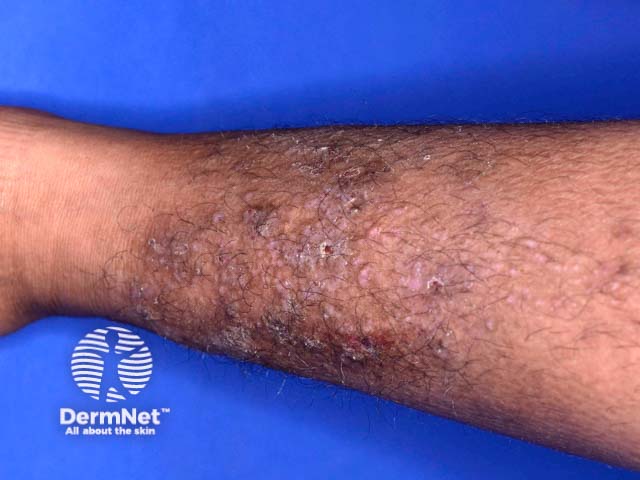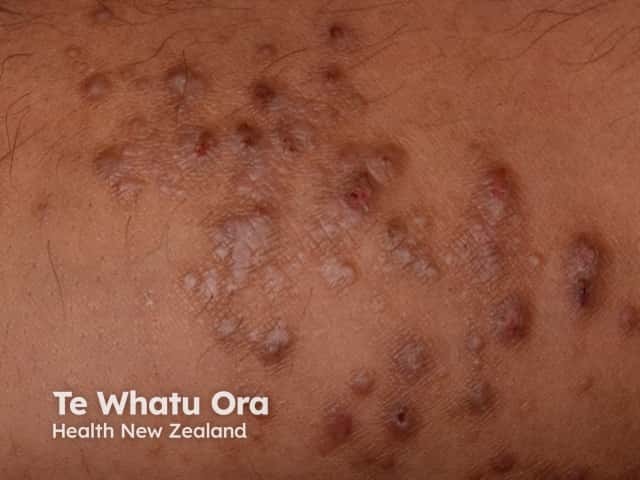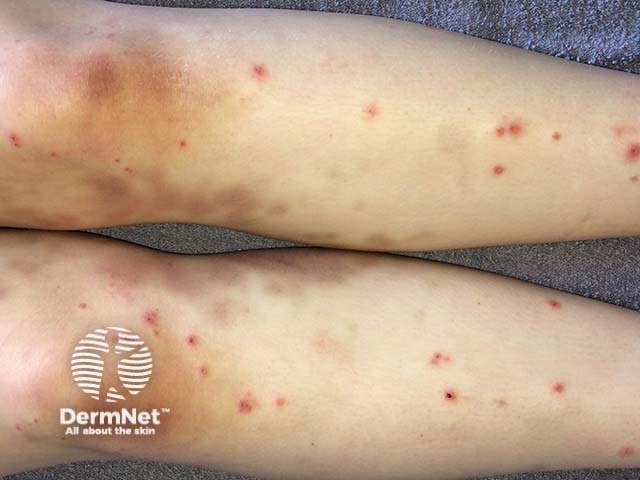Main menu
Common skin conditions

NEWS
Join DermNet PRO
Read more
Quick links
Pruritus — extra information
Pruritus
Author: Hon A/Prof Amanda Oakley, Dermatologist, Hamilton, New Zealand, 2003. Updated by Dr Sara de Menezes, Basic Physician Trainee, Alfred Health, Melbourne, Australia. December 2016.
Introduction
Clinical features
Demographics
Underlying mechanisms
Causes
Diagnosis
Treatment
Outcome
What is pruritus?
Pruritus is the medical term for itch. Itch is an unpleasant sensation on the skin that provokes the desire to rub or scratch the area to obtain relief. Itch can cause discomfort and frustration; in severe cases it can lead to disturbed sleep, anxiety and depression. Constant scratching to obtain relief can damage the skin (excoriation, lichenification) and reduce its effectiveness as a major protective barrier.
Pruritus is often a symptom of an underlying disease process such as a skin problem, a systemic disease, or abnormal nerve impulses.
What are cutaneous signs of pruritus?
There are no specific skin signs associated with pruritus, apart from scratch marks (excoriations) and signs of the underlying condition.
Persistent scratching over a period of time may lead to:
- Lichenification (thickened skin, lichen simplex)
- Prurigo papules and nodules.

Lichen simplex

Nodular prurigo

Excoriations and bruises
Who gets pruritus?
The epidemiology of pruritus depends on its underlying cause or causes. However, in general, the incidence of chronic pruritus increases with age, it is more common in women, and in those of Asian background.
Mechanisms underlying pruritus
Itch, like pain, can originate anywhere along the neural itch pathway, from the central nervous system (brain and spinal cord) to the peripheral nervous system and the skin.
Mechanisms underlying pruritus are complex.
- The itch signal is transmitted mainly through small, itch-selective C-fibres in the skin in addition to histamine-triggered and non-histaminergic neurons.
- These connect with secondary neurons which cross the opposite side of the spinothalamic tract and ascend to parts of the brain involved in sensation, emotion, reward and memory. These areas overlap with those activated by pain.
- Patients with chronic pruritus usually have both peripheral and central hypersensitisation (a heightened reaction) which means they tend to overreact to noxious stimuli which normally inhibit itch (such as heat and scratching) and also misinterpret non-noxious stimuli as an itch (eg, light touch)
The way scratching stops itching has been explained by an interaction with pain pathways within the dorsal horn of the spinal cord.
What causes pruritus?
Causes of pruritus can be classified under 5 main headings.
Localised pruritus
Localised pruritus is pruritus that is confined to a certain part of the body. It can occur in association with a primary rash (eg dermatitis) or may occur because of hypersensitive nerves in the skin (neuropathic pruritus). Neuropathic pruritus is due to compression or degeneration of nerves in the skin, on route to the spine or in the spine itself. Neuropathic itch is sometimes associated with reduced or absent sweating in the affected area of skin.
Typical causes of localised itchy rashes
- Scalp: seborrhoeic dermatitis, head lice
- Back: Grover disease
- Hands: pompholyx, irritant and/or allergic contact dermatitis
- Genitals: vulvovaginal Candida albicans infection, lichen sclerosus
- Legs: venous eczema
- Feet: tinea pedis
Neuropathic causes of localised pruritus without primary rash (cutaneous dysaesthesia)
- Face: trigeminal trophic syndrome
- Hand: cheiralgia paraesthetica
- Arm: brachioradial pruritus
- Back: notalgia paraesthetica
- Genital: pruritus vulvae, pruritus ani
- Dermatomal: herpes zoster (shingles) during the recovery phase
Scratching a localised itch may lead to lichen simplex, prurigo or prurigo nodularis.
Systemic causes of pruritus
Systemic diseases may cause generalised pruritus. This is sometimes called metabolic itch. There is nothing wrong with the skin itself, at least until it's been scratched.
Metabolic disorders include chronic renal failure (dialysis) and liver disease (with or without cholestasis).
-
Uraemic pruritus arises in patients undergoing dialysis is due to a combination of xerosis (dry skin), secondary hyperparathyroidism, peripheral neuropathy (nerve changes) and inflammation.
- Secondary hyperparathyroidism which also occurs in dialysis patients leads to microprecipitation (deposition) of calcium and magnesium salts in the skin, triggering mast cell degeneration, releasing serotonin and histamine.
- Once chronic pruritus has occurred, there may be secondary changes in the nerves in the skin and central nervous system which heighten the sensation of itch.
-
Hepatogenic pruritus is more common in intrahepatic than extrahepatic cholestasis. Examples of intrahepatic cholestasis are that associated with chronic viral hepatitis, primary biliary cirrhosis, pregnancy-related cholestasis. Extra-hepatic cholestasis is associated with pressure on the bile ducts, eg from pancreatic tumours or pseudocysts.
- Cholestasis is thought to release toxic substances from the liver, which stimulates neural itch fibres in the skin.
- Characteristically, cholestatic pruritus is most severe at night; it tends to affect the hands, feet and areas where clothes are rubbing on the skin.
Haematological disorders include iron deficiency anaemia and polycythaemia vera.
- Generalised pruritus along with glossitis (tongue inflammation) and angular cheilitis (inflammation of mouth corners) are seen in iron deficiency anaemia.
- In polycythaemia vera, the itch is usually precipitated by contact with water (aquagenic pruritus). This is thought to be mediated by the effect of platelets, serotonin and prostaglandins.
Endocrine disorders include thyroid disease and diabetes mellitus.
- In Graves' disease (thyrotoxicosis), increased blood flow, skin temperature and decreased itch threshold mediated by the increase in thyroid hormones, lead to the itch. Pruritus associated with myxoedema and hypothyroidism is rare, and if present, is more likely the result of xerosis (dry skin).
- In diabetes mellitus, localised itch tends to occur in the perianal/genital region usually due to Candida albicans or dermatophyte infections. It is unclear if metabolic abnormalities such as renal impairment, autonomic failure or diabetic neuropathy contribute to this.
Paraneoplastic itch is associated with lymphoma, especially Hodgkin lymphoma, leukaemia or a solid organ tumour (eg lung, colon, brain).
- In Hodgkin lymphoma, pruritus is thought to be caused by histamine release, which may be related to eosinophilia.
Infections causing itch include human immunodeficiency virus infection (HIV) and hepatitis C virus.
- Patients with HIV commonly complain of itch. This may be associated with skin infections/infestations, dry skin, drug reactions, hypereosinophilia (increased eosinophil levels) and cutaneous T cell lymphoma. There is a possible correlation between intractable pruritus and increased HIV viral load.
- In chronic hepatitis C infection, the mechanisms responsible for itch remain unclear. In the absence of cholestasis, pruritus may be related to antiviral therapy; it has been noted to occur in patients treated with combination therapy (interferon alfa and ribavirin).
Pruritic skin diseases
Pruritus is often a symptom of many skin diseases. Some of these are included in the following list.
- Allergic contact dermatitis
- Dry skin
- Urticaria
- Psoriasis
- Atopic dermatitis
- Folliculitis
- Dermatitis herpetiformis
- Lichen simplex
- Lichen planus
- Bullous pemphigoid
- Lice
- Scabies
- Miliaria
- Sunburn
- Pityriasis rosea
- Mycosis fungoides
Exposure-related pruritus
Pruritus may arise as a result of exposure to certain external factors.
- Allergens or irritants
- Cold, which can cause 'winter itch'
- Inducible urticaria, such as dermographism
- Aquagenic pruritus (itch on exposure to water)
- Insects and infestations, such as scabies
- Medications (topical or systemic), such as opioids, aspirin
Hormonal reasons for pruritus
About 2% of pregnant women have pruritus without any obvious dermatological cause. In some cases the itch is due to cholestasis (pooling of bile in the gall bladder and liver). It usually occurs in the 3rd trimester and is relieved after giving birth.
Generalised itch is also a common symptom of menopause.
How is pruritus diagnosed?
The first steps of evaluation of an itchy patient are medical history and examination.
A thorough history can identify constitutional symptoms that may point towards an underlying systemic disease. Drug triggers such as opioids may be identified, especially if the commencement of the drug relates to the itch.
A careful examination can identify dermatological causes for the itch (eg scabies, lichen simplex, pemphigoid) or evidence of chronic skin changes related to the itch. In dermatological causes of pruritus, primary skin lesions will usually suggest the diagnosis. Patients without primary skin lesions and little evidence of chronic scratching should be investigated for systemic, neuropathic and psychogenic causes.
The panel of investigations could include:
- Full/complete blood count
- Creatinine and renal function tests
- Liver function tests
- Thyroid function tests
- Erythrocyte sedimentation rate
- Chest radiography
- HIV serology.
What treatment is available for itch?
The management of pruritus relies on establishing the cause and then either removing or treating the cause to prevent further itching. In many cases, tests are necessary to determine the cause; while these are in progress, treatment to provide symptomatic relief of pruritus may be given.
Topical treatments
In addition to specific therapy for any underlying skin or internal disease, topical treatment may include:
- Wet dressings or tepid shower to cool the skin
- Calamine lotion (contains phenol, which cools the skin): avoid on dry skin and limit use to a few days
- Menthol/camphor lotion: gives a chilling sensation
- Local anaesthetics, such as pramoxine (also called pramocaine), applied to small itchy spots such as insect bites
- Regular use of emollients, especially if skin is dry
- Mild topical corticosteroids for short periods
- Topical calcineurin inhibitors are also used to reduce itch associated with inflammatory skin conditions
- Topical doxepin, a tricyclic antidepressant and antihistamine, is an antipruritic used in eczema.
Other measures that can be useful in preventing pruritus include avoiding precipitating factors such as rough clothing or fabrics, overheating, and vasodilators if they provoke itching (eg, caffeine, alcohol, spices). Fingernails should be kept short and clean. If the urge to scratch is irresistible then rub the area with your palm.
Topical antihistamines should not be used for chronic itch, as they may sensitise the skin and result in allergic contact dermatitis.
Systemic therapy
If pruritus is severe and sleep is disturbed treatment with oral medication may be necessary. Some drugs may help to relieve the itch whilst others are given solely for their sedative effects.
- Antihistamines are most useful in urticaria, in which histamine is released. Use for other pruritic conditions is not supported by randomised control trials. Sedating antihistamines may be used for their sedative effects.
- Doxepin and amitriptyline are tricyclic antidepressants have antipruritic action and act on the central and peripheral nervous systems.
- Tetracyclic antidepressants such as mirtazepine and selective serotonin reuptake inhibitors (paroxetine, sertraline, fluoxetine) may also help some patients with severe itch including when it is caused by cholestasis, T-cell lymphoma, malignancy or a neuropathic cutaneous dysaesthesia.
- Anti-epileptic drugs such as sodium valproate, gabapentin and pregabalin may also be of benefit to some patients, e.g., those with itch associated with renal failure or neuropathic itch. The mechanism of action is uncertain.
- Opioid antagonists such as butorphanol intranasal spray, naltrexone tablets, and naloxone have been effective in patients suffering from intractable pruritus in association with liver disease, atopic eczema and chronic urticaria. Nalfurafine, which is a kappa-opioid agonist has also been studied and shown to reduce itch associated with chronic renal impairment, however, it is not widely available.
- Aspirin is sometimes effective if pruritus is mediated by kinins or prostaglandins and is noted to be effective in patients with pruritus due to polycythaemia vera. Note: aspirin may cause or aggravate itch in some patients.
- Thalidomide has been successful in treating nodular prurigo and chronic pruritus of various kinds but is rarely used because of serious adverse effects and expense.
- Rifampicin is effective for patients with pruritus associated with cholestasis (some forms of liver disease).
- Isolated case reports in severe itch associated with malignancy have reported success with the NKR1 antagonist, aprepitant (normally used short-term for postoperative or chemotherapy-induced nausea). This is under investigation for neuropathic itch and nodular prurigo.
- Some biological agents: eg, lebrikizumab has demonstrated a sustained reduction in atopic dermatitis-related itch as early as two days after commencing treatment.
Phototherapy
Ultraviolet B (UVB) phototherapy alone, or in conjunction with UVA, has been shown to be helpful for pruritus associated with chronic kidney disease, psoriasis, atopic eczema and cutaneous T-cell lymphoma.
Behavioural therapy
Behavioural therapy may be used in conjunction with pharmacotherapy to modify behaviours such as coping mechanisms and stress reduction, which help interrupt the itch-scratch cycle. One randomised controlled trial showed short-term benefits with a reduction in itch frequency and scratching as well as improvement in coping mechanisms.
What is the outcome for pruritus?
The management of chronic severe itch is difficult and often requires the use of combination therapy over a long period of time. Identification and treatment of underlying conditions causing pruritus may help in this process. The symptom may quickly disappear or persist for long periods of time.
References
- Rook/Wilkinson/Ebling Textbook of Dermatology (6th Edition 1998)
- Pathogenesis and treatment of pruritus in cholestasis. Kremer AE, Beuers U, Oude-Elferink RP, Pusl T. Drugs. 2008;68(15):2163-82. Medline.
- Dhand A, Aminoff MJ. The neurology of itch. Brain. 2013 Jun 22. [Epub ahead of print] PubMed PMID: 23794605.
- Tarikci N, Kocaturk E, Gungor S, Topal IO, Can PU, Singer R. Pruritus in systemic diseases: a review of etiological factors and new treatment modalities. Scientific World J [Internet]. 2015 Jun [cited 2016 June 29]; 2015. Available from: http://dx.doi.org/10.1155/2015/803752
- Yosipovitch G, Bernhard JD. Chronic Pruritus. N Engl J Med. 2013 Apr;368:1625-34. Journal
On DermNet
- Differential diagnosis of very itchy skin
- Cutaneous dysaesthesia
- Paraneoplastic pruritus (cancer itch)
Other websites
- Itching — Medline Plus
- Pruritus and Systemic Disease — Medscape Reference
